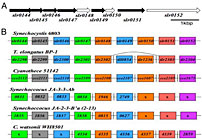- Number 293 |
- August 17, 2009
On the light path to bioenergy
Pollutant-free fuel cells require a cheap, abundant source of hydrogen fuel. Plants, algae, and blue-green bacteria produce hydrogen by harvesting sunlight and using the energy to split water. This reaction is done by a large protein complex that slowly degrades and must be regenerated. A study by scientists from DOE’s Pacific Northwest National Laboratory and Washington University in St. Louis shed new light on how this protein complex, called Photosystem II, regenerates. Working at DOE’s EMSL, the team found a novel cluster of genes that encode six proteins. These six proteins help put Photosystem II back together. “This can lead to a better understanding of how these proteins work, which could alter how we view this entire process," said PNNL’s Jon Jacobs.
In the representation of the nine-gene operon in (A) the cyanobacteria Synechocystis 6803 and (B) other cyanobacteria, the black arrows indicate open reading frames whose products were observed to be differentially expressed in Photosystem II complexes isolated from various mutant strains. The slash indicates genes are not clustered. X indicates that there is no ortholog, or similar gene, in the genome. The numbers correspond to the gene designation or contig number in various cyanobacteria.
[Kristin Manke, 509.372.6011,
kristin.manke@pnl.gov]

